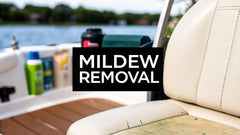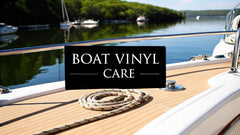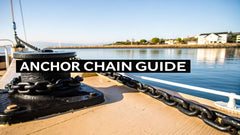Finding the Best Pontoon Boat Accessories
The best pontoon accessories aren't always the flashiest or most expensive ones. They're the ones that actually match how you spend your time on the water, whether that's upgrading comfort with plush seating, adding some thrill with a ski tow bar, or just getting peace of mind with high-quality fenders and anchors. It’s all about tailoring your boat to your life.
From Basic to Brilliant: Building Your Ultimate Pontoon
Picture your perfect day out on the lake—sun's out, the playlist is just right, and your pontoon is ready for whatever you have planned. This guide is about more than just bolting on a few add-ons; it’s about strategically upgrading your boat into a true hub for family fun, serious fishing, or high-energy watersports.
We'll break down the essentials and show you how to pick the right gear for the way you boat. Think of this as your blueprint for turning a good day on the water into a great one, one smart accessory at a time.
First Things First: What’s Your Pontoon’s Job?
Before you start clicking "add to cart," take a minute to think about what you want your pontoon to be. Is it a quiet getaway for casting a line at sunrise? A buzzing activity platform for tubing with the kids? Or is it your floating lounge for sunset cocktails with friends?
Figuring this out is the most important first step. It immediately tells you which upgrades will give you the most bang for your buck. A family obsessed with watersports is going to get way more value from a sturdy ski tow bar than a group that just wants to relax with premium cup holders and a rail-mounted grill.
This push for personalization is a huge trend. The global boat accessories market was valued at around USD 5 billion in 2023 and is only expected to grow. It shows that boaters everywhere are investing more to make their vessels a perfect fit for their lifestyle. You can dive deeper into the boating accessories market trends to see just how big this movement is.
Before we dive into specific product recommendations, let's get a high-level view of how different accessory categories can enhance your experience.
Top Pontoon Accessory Upgrades at a Glance
| Accessory Category | Primary Benefit | Example Accessories |
|---|---|---|
| Safety & Navigation | Peace of mind and confident control on the water. | Life Vests, Dock Lines, Anchors, GPS/Fish Finders |
| Comfort & Shade | Extends your time on the boat by keeping everyone relaxed. | Bimini Tops, Upgraded Seats, Cup Holders, Tables |
| Fun & Entertainment | Maximizes enjoyment and creates lasting memories. | Sound Systems, Water Slides, Grills, Ski Tow Bars |
| Protection & Maintenance | Protects your investment for years of future use. | Boat Covers, Fenders, Cleaning Kits, Engine Flushers |
This table gives you a simple framework for thinking about your next upgrade, ensuring it aligns with what you truly need.
Key Accessory Categories to Consider
To keep things organized, it helps to think about upgrades in a few key categories. Each one plays a specific role in making your time on the water better.
-
Safety and Navigation: This is your foundation. We're talking about the non-negotiables like life jackets and anchors, plus modern essentials like a good GPS that let you relax and enjoy the day.
-
Comfort and Shade: These are the items that turn your pontoon into a floating living room. Think Bimini tops for escaping the midday sun and seating upgrades that make all-day lounging a pleasure.
-
Fun and Entertainment: This is where the magic happens. From high-quality sound systems that set the mood to water slides and grills that turn your boat into the ultimate party platform, this category is all about pure enjoyment.
-
Protection and Maintenance: A pontoon is a big investment, and this gear helps you protect it. Quality covers and the right cleaning supplies will keep your boat looking and running great for years to come.
By focusing on accessories that directly support your favorite activities, you ensure every dollar spent enhances your time on the lake. The "best pontoon boat accessories" aren't universal—they're the ones that are best for you.
Building Your Foundation of Safety and Navigation
An unforgettable day on the water really starts with peace of mind. Before you even begin thinking about fancy grills or bumping sound systems, the very first accessories to get for your pontoon should be the ones that build a solid foundation of safety and navigation. This isn't just about checking off a list of required gear; it's about having genuine confidence and control out on the water.
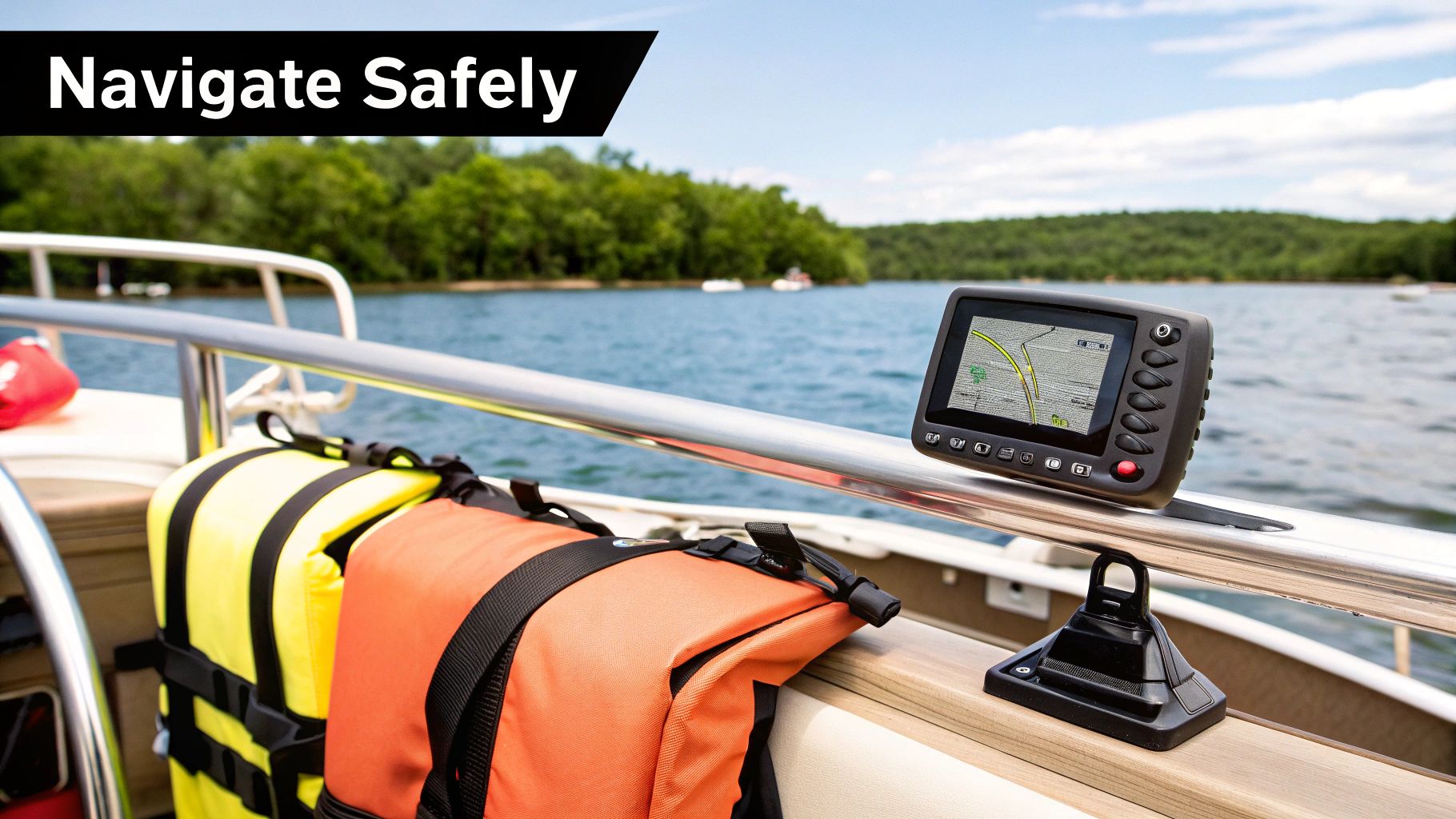
Think of these items as your boat’s seatbelt and airbags. You hope you never have to use them, but knowing they're there lets you relax and truly enjoy the ride. From life jackets that actually fit comfortably to GPS units that make exploring a new cove totally stress-free, this is the bedrock of responsible boating.
It’s a big market for a reason. Recreational boat parts and accessories are projected to grow from USD 16.67 billion in 2024 to an estimated USD 24.27 billion by 2035. That boom is driven by boaters just like you demanding safer, more reliable technology.
Life Jackets: The Ultimate Non-Negotiable
The single most critical piece of safety gear on any pontoon is the Personal Flotation Device (PFD), or life jacket. While the rules require having one for every person on board, the real goal is safety and comfort—not just compliance. Let's be honest, a bulky, uncomfortable PFD is one that nobody wants to wear.
Modern PFDs come in all sorts of styles for different activities, so it’s smart to have a mix on hand to suit your crew.
- Type III Vests: These are your classic, all-around vests for recreational boating. They offer good mobility for fishing or just cruising and are comfortable enough to wear all day.
- Inflatable PFDs: Absolutely perfect for adults who are confident swimmers. These low-profile options are so lightweight and unobtrusive you'll forget you're wearing one. They inflate automatically when they hit the water or can be manually triggered, giving you serious buoyancy without the bulk.
- Children's Vests: This is one area where you never compromise. A child’s PFD must fit snugly and have key features like a crotch strap (to keep it from riding up) and a grab handle for a quick and easy retrieval.
Having the right number of life jackets is the law; having the right type of life jackets is just smart boating. Comfort is key because it encourages people to actually wear them, which is the whole point.
Essential Gear for Every Single Outing
Beyond PFDs, a well-stocked pontoon needs a few other crucial items. These are the tools that handle the small problems before they turn into big ones.
Using a comprehensive boat safety equipment checklist is a great way to make sure you haven’t forgotten anything before you push off the dock.
Your Onboard Safety Kit Should Include:
- Fire Extinguisher: A B-I rated marine fire extinguisher is a must-have. Make sure it's mounted somewhere easy to get to and that everyone on board knows how to operate it.
- First-Aid Kit: Go for a marine-specific first-aid kit. They’re usually waterproof and stocked with supplies for the kinds of minor injuries that happen on a boat.
- Signaling Devices: Keep a whistle, an air horn, and visual distress signals (like flares or an orange flag) to get attention if you're in trouble.
- Throwable Flotation Device: A Type IV device, like a life ring or a buoyant cushion, needs to be ready to toss to someone in the water at a moment's notice.
Navigating with Modern Confidence
Getting lost is no fun, and running aground can wreck your day—and your boat. Modern navigation accessories have been total game-changers for pontoon owners, putting an incredible amount of information right at your fingertips.
A combination GPS and fish finder unit is easily one of the best accessories you can add, whether you're exploring or angling. The GPS shows your exact spot on a detailed map, lets you drop pins on favorite fishing holes, and guides you back to the ramp safely, even if fog rolls in. The fish finder uses sonar to show you water depth, what the bottom looks like, and, of course, where the fish are hiding. It just adds another layer of fun to every trip.
Designing Your On-the-Water Living Room
Think of your pontoon less like a boat and more like your floating living room. It's your personal oasis, the spot where you get away from it all. To get that true kick-back-and-relax vibe, comfort is everything. This is where you swap out the purely functional for pieces that make your pontoon a genuine escape, complete with comfy seating and plenty of shade to keep you on the water for hours.
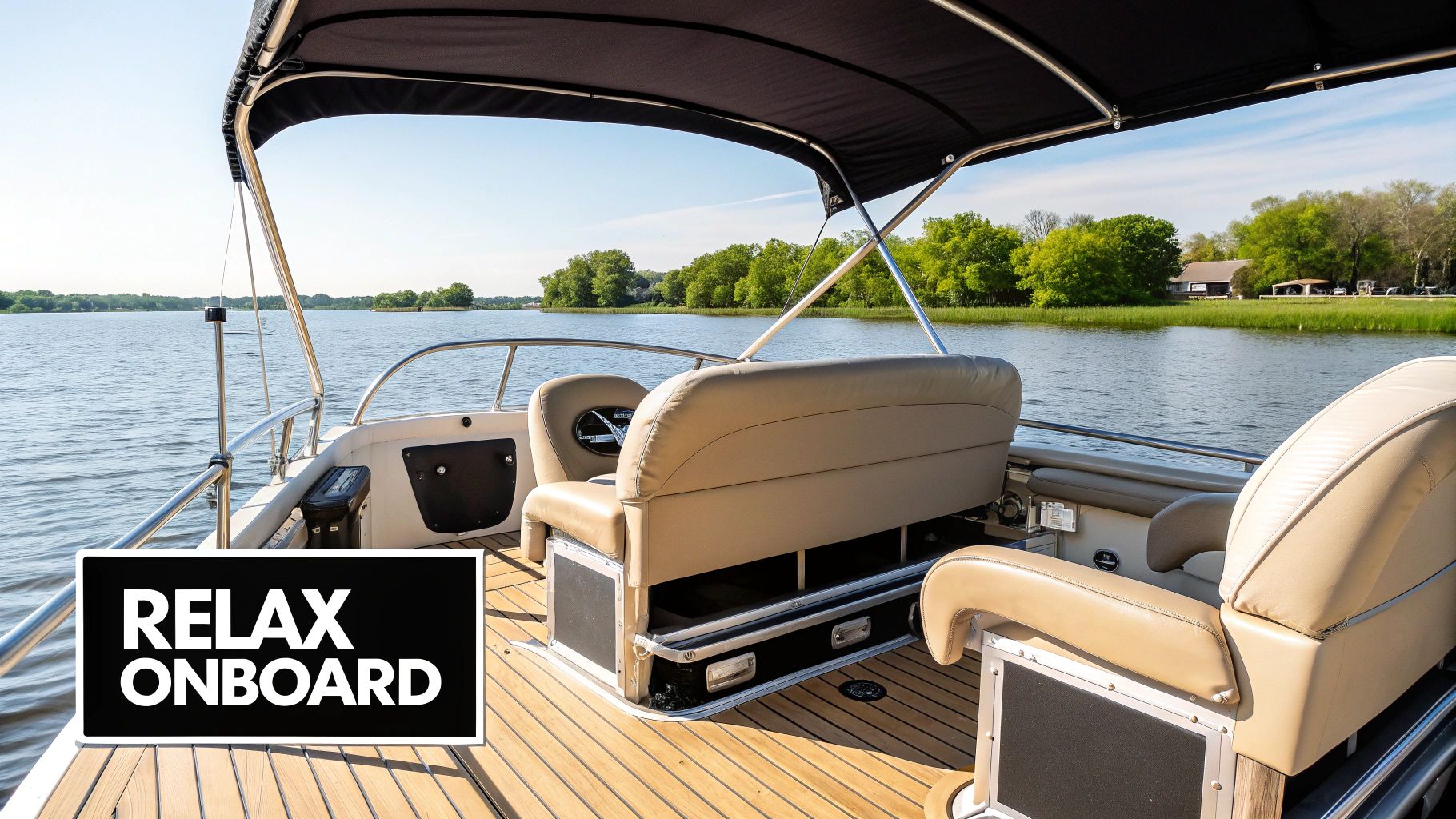
Just a few upgrades to the core comfort elements can completely transform the feel of your boat. Moving from standard benches to better furniture and adding a solid shade solution are two of the biggest bang-for-your-buck investments you can make. With modern pontoons easily seating 8 to 15 passengers, they’re the ultimate party barge, which makes premium seating and big canopies essential. It's a major reason for their popularity, as you can discover more insights about pontoon boat trends on towardsautomotive.com.
Rethinking Your Seating Arrangement
The seats that come from the factory are fine. They do the job. But "fine" isn't what we're going for, is it? Upgrading your furniture is one of the fastest ways to level up your whole boating experience. The trick is to only look at furniture built with marine-grade materials. We're talking vinyl that laughs at UV rays, foam that doesn't turn into a sponge, and frames that won't rust after one season.
Here are a few popular swaps to consider:
- Captain's Chairs: Ditch the standard helm seat for a high-back captain's chair with armrests and maybe even a recline feature. Your back will thank you after a long day at the wheel.
- Flip-Flop Seats: These clever benches have a backrest that swings either way. Passengers can face forward to join the conversation or flip it back to watch the tubers and skiers.
- L-Group Loungers: This setup instantly creates a cozy, conversational corner on your boat, perfect for socializing. Bonus: many have built-in storage or coolers right underneath.
The Ultimate Comfort Accessory: Shade
Nothing kills a perfect day on the water faster than getting baked by the sun. Good shade isn't just a nice-to-have; it's a must for both comfort and health. While you have options, the Bimini top is the undisputed king for pontoons.
A well-chosen Bimini top does more than just block the sun. It defines the usable space on your boat, creating a cool, comfortable zone where your family and guests will naturally want to gather.
Choosing the right one is about more than just picking a color that matches your boat. You have to nail the measurements to get that perfect fit and maximum coverage.
How to Measure for a Perfect Bimini Fit
- Measure the Width: First, figure out where you want the top's main pivot points to mount on your boat's rails. Measure the distance between those two spots—that’s your width.
- Determine the Height: Hop in your boat and measure from your chosen mounting points straight up to the height you want the top to be. Give yourself enough headroom to walk around without ducking.
- Choose the Length: Last, decide how much of the boat you want covered. Bimini tops for pontoons usually come in lengths from 8 to 10 feet, which provides a ton of shade.
For the ultimate sun protection, some owners even go for a double Bimini top. This is exactly what it sounds like: two separate tops that can cover nearly the entire deck. It's a fantastic solution for large groups or families with young kids who need to stay out of the sun.
Exploring Other Shade Solutions
While the Bimini is the go-to, a few other clever accessories can round out your shade strategy. A big, rail-mounted boat umbrella can provide targeted shade wherever you need it—perfect for when you're anchored and swimming.
And for those who boat in cooler areas or just want to stretch the season a bit longer, a full pontoon enclosure is a game-changer. These zip-on panels create a protected room on your boat, shielding everyone from wind and rain while still giving you that million-dollar view.
Upgrading Your Pontoon for Fun and Entertainment
Once you’ve got safety and comfort dialed in, it’s time to get to the real reason you bought a pontoon in the first place—to have an absolute blast. This is where your boat transforms from a simple cruiser into the ultimate on-water party deck and activity hub. The right accessories can completely redefine what a day on the lake means for you and your guests.
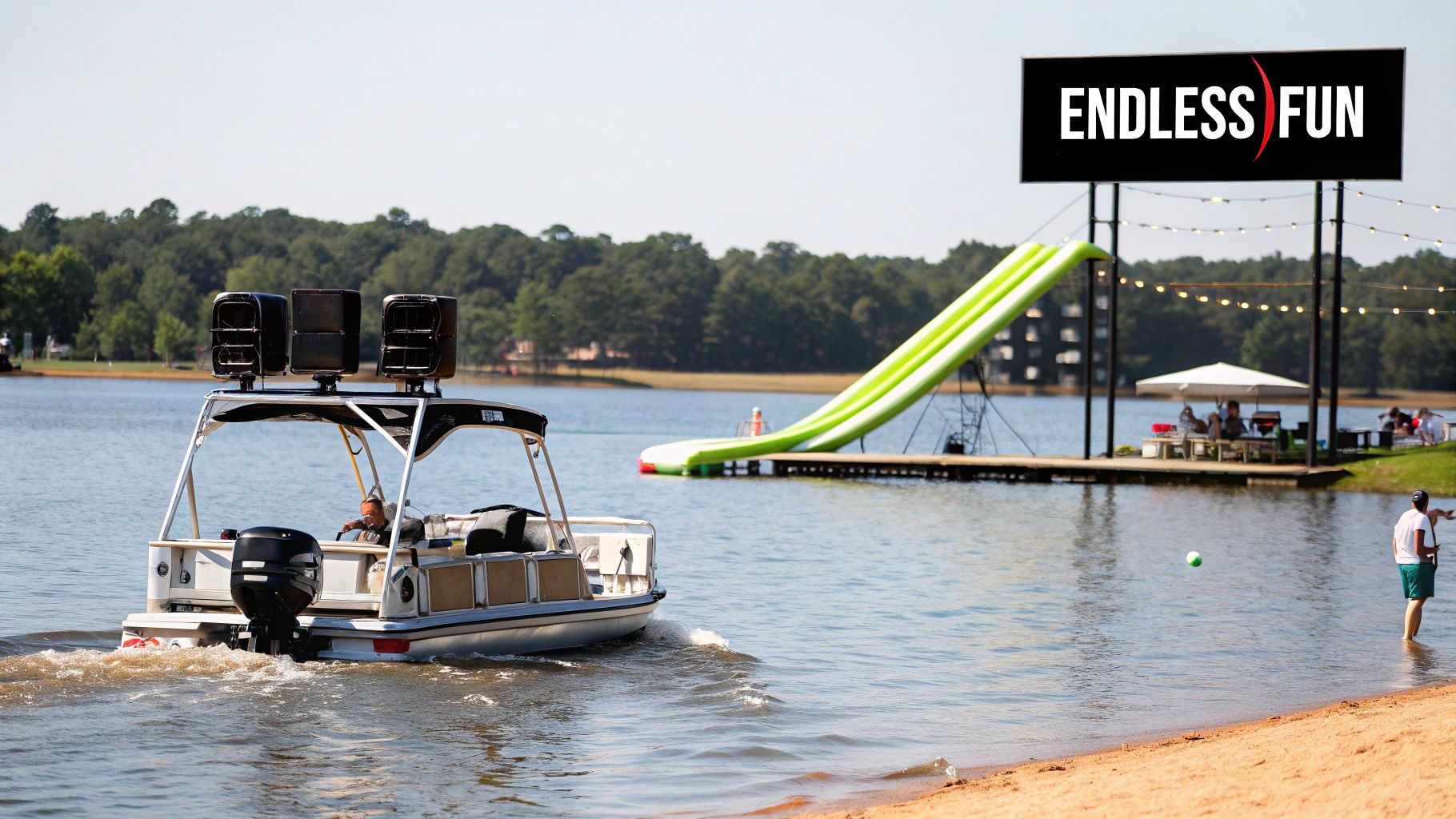
From installing a sound system that brings your favorite playlist to life to adding the gear that unlocks a world of watersports, these upgrades are all about maximizing the fun factor. We’ll cover how to turn up the volume, add some thrills, and even grill up a perfect meal, making sure your boat is the go-to spot on the water.
Setting the Soundtrack for Your Day
Music is the heartbeat of any great get-together, and your pontoon is no exception. A quality sound system does more than just play tunes; it sets the entire mood for the day. While the speakers that came with your boat are a decent starting point, a real marine-grade audio upgrade is one of the best investments you can make for an incredible experience.
A great system usually includes:
- A Marine-Grade Head Unit: This is the brains of your setup. Get one with Bluetooth so anyone can easily play DJ right from their phone.
- Well-Placed Speakers: Marine speakers placed strategically around the boat mean everyone from the bow to the stern can hear the music clearly, without blasting out those sitting closest.
- A Subwoofer: If you really want to feel the music, a subwoofer is non-negotiable. It adds that deep, rich bass that standard speakers can't touch, turning your pontoon into a floating concert.
Adding High-Octane Watersports Action
For families with kids or anyone who loves an adrenaline rush, adding watersports capability is a total game-changer. Pontoons are surprisingly good tow boats, but only when you have the right gear. And please, forget trying to tie a tow rope to the boat's cleats—it's incredibly unsafe and can cause serious damage to your boat. You need a dedicated tow point.
Your two main options are a ski tow bar or a turbo swing. A ski tow bar is a beefy, elevated bar that mounts near the stern, lifting the rope high above the water and the engine. This creates a much smoother, more effective pull for tubers, water skiers, and wakeboarders.
The turbo swing is a neat alternative that wraps around your outboard motor. It uses a pulley that slides along the bar, providing a smooth and consistent pull through turns. Both are fantastic additions that open up a whole new world of active fun on the water.
Investing in a proper tow point isn't just about performance; it's a critical safety upgrade. It provides a secure, engineered connection designed to handle the immense forces generated during watersports, protecting both your passengers and your boat.
Creating Your Personal Water Park
The fun doesn't have to stop when the engine does. Some of the coolest pontoon accessories are all about extending your living space right out onto the water. These are perfect for when you've dropped anchor in a quiet cove and everyone is ready to cool off.
- Inflatable Water Mats: These massive floating lounges are everywhere for a reason. They create a stable, floating island where kids can play for hours and adults can relax right on the water.
- Pontoon Slides: An inflatable slide attached to the side of your boat is a guaranteed hit. It's an easy way to provide endless entertainment, especially for the younger members of your crew.
- Floating Coolers: Keep drinks within arm's reach of swimmers by tethering a floating cooler to the boat. It’s a simple accessory that adds a huge amount of convenience to your swim time.
Grilling and Chilling on the Water
There’s something uniquely satisfying about grilling while floating on a calm lake. A rail-mounted pontoon grill lets you cook up burgers, hot dogs, or the day's catch without ever having to head back to shore.
When you're picking a grill, safety and stability are everything. You'll want a marine-grade grill made from stainless steel to fight off rust. Most importantly, it needs a sturdy mount designed specifically to clamp securely to your pontoon's railings. This ensures it stays put, even if a wake rocks the boat. Just remember to always grill in a well-ventilated spot, far away from your Bimini top or any other flammable materials.
Mastering the Essentials of Anchoring and Docking
Let’s get into the nitty-gritty skills that really separate a seasoned boater from a rookie. Anchoring and docking can feel high-stakes, but with the right gear in your corner, those stressful moments turn into smooth, confident maneuvers. This section is all about demystifying the essential accessories for securing your boat, whether you're dropping anchor for a swim in a quiet cove or sliding into a busy marina slip.
Think of your anchoring and docking gear as your boat's parking brake and bumpers. You wouldn't dream of parking a car on a steep hill without them, right? The same logic applies on the water. We'll kick things off with anchors, breaking down the main types so you can find the perfect match for your pontoon and the kind of lakebeds you'll be on. After that, we’ll get into the art of docking like a pro.
Choosing the Right Anchor for Your Pontoon
An anchor isn’t just a chunk of heavy metal you toss overboard; it’s a specialized tool engineered to dig into the lake bottom and hold your boat steady against wind and current. Using the wrong anchor for the conditions is almost as useless as having no anchor at all. Your decision should really come down to the type of lakebed you hang out on most often.
To get you started, here is a quick look at the most common anchor types and where they really shine.
Pontoon Anchor Selection Guide
Choosing the right anchor from the get-go saves a ton of frustration. The biggest factor is matching the anchor style to the bottom composition of your favorite lakes and rivers. This table breaks down the pros and cons of the most popular options for pontoon boaters.
| Anchor Type | Best For (Bottom Type) | Holding Power | Pros | Cons |
|---|---|---|---|---|
| Fluke (or Danforth) | Sand, Firm Mud | Excellent | Lightweight, easy to store, great holding | Can struggle to set in rock, weeds, or grass |
| Mushroom | Soft Mud, Silt | Good | Simple design, works well in very soft beds | Low holding power on hard or sandy bottoms |
| Box | Rock, Weeds, Various | Very Good | Sets quickly, versatile, folds for storage | Can be bulky, less effective in deep mud |
Ultimately, the best anchor is the one that reliably holds your boat in your boating environment. Take a minute to think about where you'll be dropping anchor most often, and the choice becomes much clearer.
This simple decision tree helps visualize how to pick the best anchor based on your local lakebed conditions.
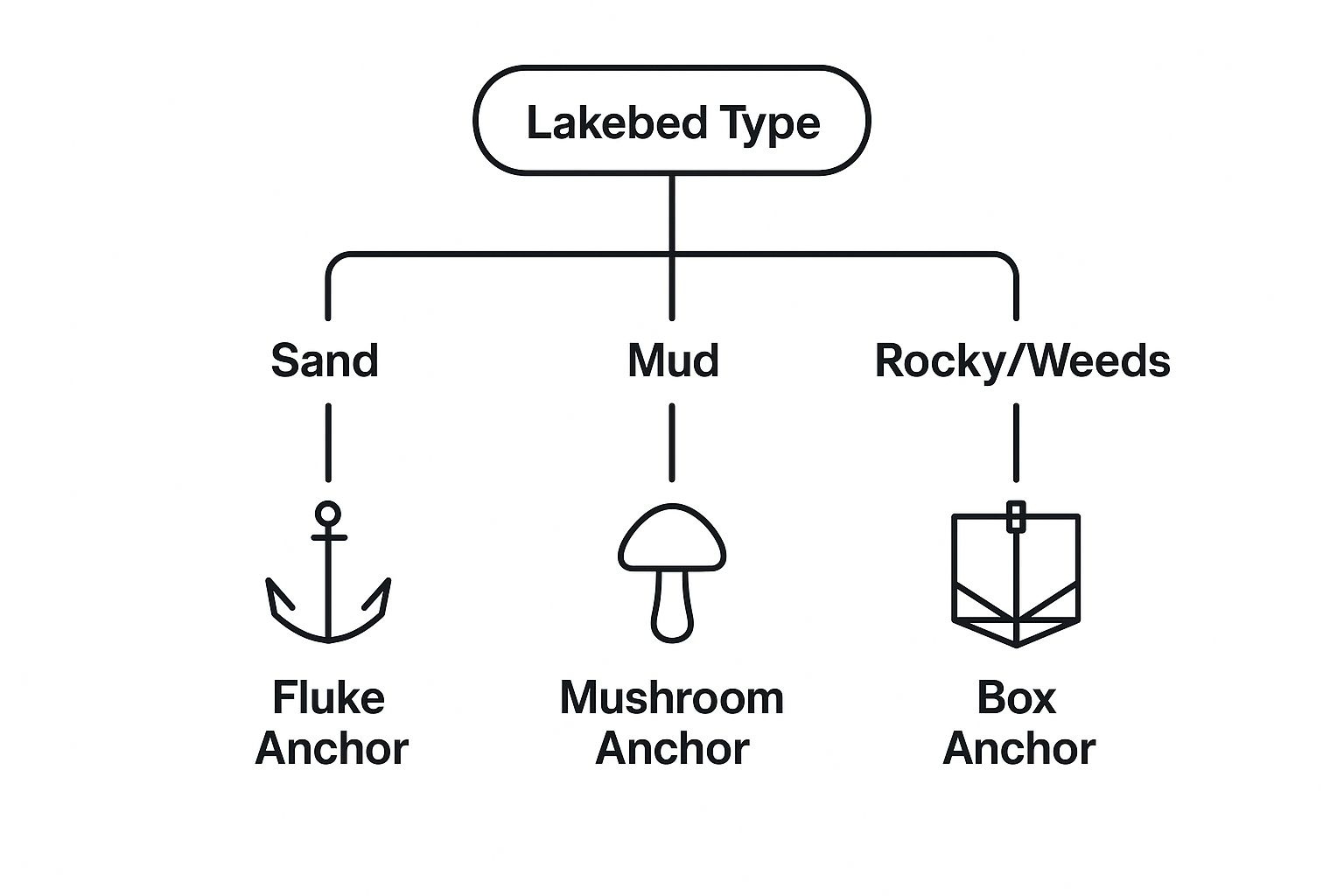
As you can see, matching your anchor style to the environment is the most important part of getting a reliable hold. For a deeper dive, check out our guide on the three best pontoon anchors for every condition to make sure you nail the choice.
Docking Like a Pro with Fenders and Lines
Pulling up to the dock can be intimidating for anyone, but the right accessories can turn a nerve-wracking approach into just another part of the routine. The two key players here are fenders and dock lines.
Fenders, which you’ll often hear called boat bumpers, are your pontoon’s first line of defense against scrapes, dings, and ugly dock rash. They are absolutely non-negotiable if you want to protect your investment.
Think of fenders as your boat’s personal bodyguards. They take the hit, absorbing the impact between your pontoon and the dock to prevent costly cosmetic damage and keep your boat looking sharp.
When it comes to picking fenders, size really does matter. A good rule of thumb is to use one inch of fender diameter for every four to five feet of your boat's length. For most pontoons, fenders between 6.5 and 8.5 inches in diameter are the sweet spot. You’ll want at least three of them: one for the bow, one for the stern, and one to place at the widest point of your boat.
Dock lines are simply the ropes you use to tie your pontoon securely once you're at the dock. Look for lines made from double-braided nylon—they have the perfect blend of strength and stretch to absorb the shock from waves and wind without snapping. You should have at least four lines: two for the bow, two for the stern, and maybe a couple of extra "spring" lines for longer stays or rougher weather. Taking a few minutes to master essential knots like the cleat hitch and the bowline will make tying up a quick, secure, and stress-free process.
Protecting Your Investment with Covers and Care
Keeping your pontoon in great shape is more than just about pride. It's about protecting its value and making sure it's ready to go for years of good times on the water. This really boils down to having the right accessories to shield it from the elements and make maintenance a simple task, not a weekend-long chore.
The single most important piece of protective gear you can own is a high-quality boat cover. Think of it as your boat’s personal garage, protecting it from sun, rain, bird messes, and falling leaves when you're not out enjoying it. A solid cover is your first defense against UV rays that fade upholstery and crack vinyl, saving you a fortune in repairs down the road.
Choosing the Right Pontoon Boat Cover
Not all boat covers are made the same, and the best one for you really depends on how you use and store your pontoon. There are two main types, and knowing the difference is the key to getting the protection you actually need.
- Mooring Covers: These are your lighter-weight, daily-use covers. They’re perfect for when your boat is tied up at the dock or on a lift for a few days. They are designed to be put on and taken off quickly and easily.
- Storage Covers: Built tough from heavy-duty, weather-resistant fabric, these are what you need for long-term or off-season storage. They offer serious protection from harsh weather like snow, ice, and intense sun.
A custom-fit cover is almost always worth the extra money. A generic, universal cover might save you a few bucks upfront, but a snug fit prevents water from pooling up and stops the wind from whipping underneath it, which offers far better protection in the long run.
The cover's material is just as important as its fit. You’ll want to look for marine-grade polyester or acrylic fabrics treated for both UV and mildew resistance. This ensures the cover can stand up to the sun without falling apart and won't turn into a moldy mess in damp weather. For a deep dive into the best options, check out this guide on the four best pontoon boat covers to find the perfect match.
Essential Cleaning and Maintenance Supplies
A great cover is your first line of defense, but regular cleaning is what keeps your boat looking like it just left the showroom. Using the right supplies is critical—household cleaners are often too harsh and can strip wax or damage marine-grade vinyl and fabrics.
Your basic cleaning kit only needs a few key items made specifically for boats. A good marine-grade soap will cut through lake grime and algae but will be gentle on your boat's finish and safe for the water. After washing, a quality vinyl cleaner and conditioner will keep your seats soft, prevent cracking, and add a layer of UV protection.
Finally, a few simple organizational items can make cleanup a breeze. One of the handiest pontoon accessories you can get is a small, rail-mounted trash can. It gives you a perfect spot for empty cans and snack wrappers, keeping your deck tidy and preventing trash from blowing into the water.
Common Questions About Pontoon Accessories
Figuring out how to outfit your pontoon can stir up a lot of questions. This is true whether you're a first-time owner staring at a blank canvas or a seasoned boater looking for the next smart upgrade. Getting straight answers helps you put your money where it counts and get the most out of every purchase.
Let's clear the air on some of the most common questions we hear. The idea is to help you move past any uncertainty and start picking accessories that will genuinely make your time on the water better.
What Should a New Pontoon Owner Buy First?
When you’re just getting started, it’s ridiculously easy to get overwhelmed by the sheer number of gadgets and gear out there. The best way to approach it is to forget the fancy stuff for a minute and lock down the absolute fundamentals: safety, protection, and basic function.
To keep it simple, make these three things your top priority:
- A Complete Safety Kit: This is totally non-negotiable. Start with a full set of USCG-approved life jackets that fit properly for every single person you might have on board. Then, add a marine-grade fire extinguisher, a solid first-aid kit, and something to make noise with, like an air horn or whistle.
- A High-Quality Boat Cover: Your pontoon is a huge investment, and a good cover is its first line of defense against just about everything. It shields your expensive upholstery and deck from brutal sun damage, rain, and random debris, saving you thousands in preventable repairs down the road.
- A Reliable Anchor and Dock Lines: You need to be able to stop and stay put, whether it's for a swim or to cast a line. An anchor that’s sized correctly for your boat and the waters you'll be in is critical. Same goes for a good set of fenders and dock lines—they make pulling up to the marina a calm, stress-free experience instead of a frantic scramble.
Are Expensive Marine-Grade Electronics Worth It?
Short answer? Absolutely, yes. It’s tempting to try and save a few bucks by rigging up standard car audio or a regular GPS, but that's a decision that almost always ends in regret. Marine-grade equipment is engineered from the ground up to survive in a harsh environment that will kill consumer electronics in short order.
Investing in marine-grade electronics isn't about luxury; it's about reliability and longevity. They are built to withstand constant moisture, heavy vibration, and direct UV exposure, ensuring they work when you need them most.
This gear is built differently. It has waterproof seals, internal parts coated to resist corrosion, and screens you can actually see in bright sunlight. A marine-grade stereo or fish finder is simply going to perform reliably for years, making it a much smarter long-term buy for your boat’s function and your own safety.
At Better Boat, we provide everything you need to keep your pontoon in top condition. Explore our full range of pontoon boat accessories, cleaning supplies, and safety gear.


